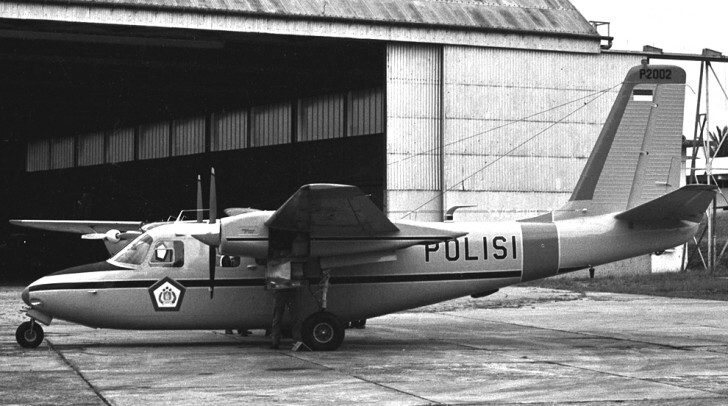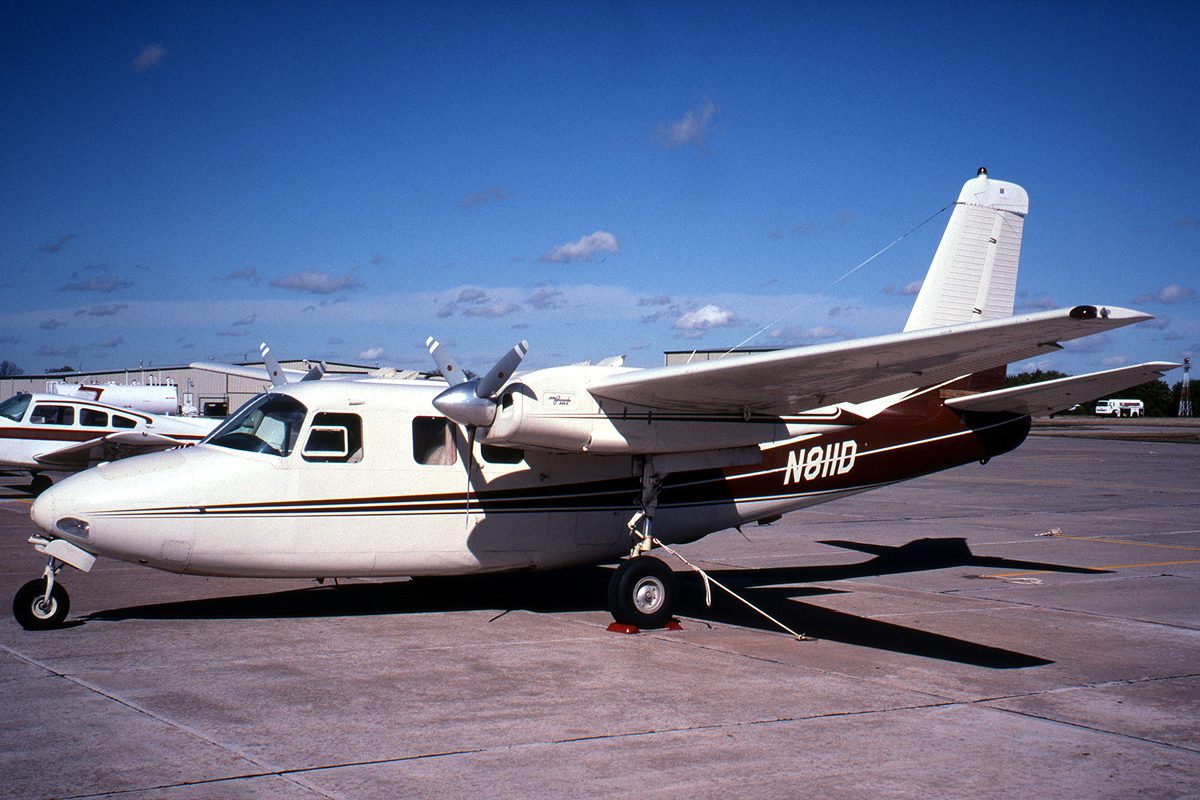By Barry Collman

Scanned from a negative taken by an unknown photographer, P-2002 is serial number 500A-1049-44. First certified in April 1961 as N6209X, it was exported to Indonesia for the Angkatan Kepolisian (Indonesian Police) and delivered be the Air Carrier Service Corporation of Washington, DC. It was withdrawn from service by 2010 and is now displayed at the home base of the Police, Pondok Cabe, mounted on a pole.
The Model 500A was the ninth one to be placed into production, the first 31 by the Aero Design & Engineering Company, as a subsidiary of Rockwell-Standard Corporation, at Bethany (Wiley Post Airport), Oklahoma City, Oklahoma, and the last 68 by Aero Commander Inc. as a subsidiary of Rockwell-Standard Corporation. The 500A was the first of the “Speedline” nacelle models.
The 99 examples were built between February 1960 and January 1963, with serial numbers in the range 500A-871-1 through 500A-1276-99, although serial number 500A-871-1 was later converted to the first Model 680F, serial number 680F-871-1.
Of these, 36 were initially certified in 1960; 22 in 1961; 34 in 1962; and 7 in 1963.
Later, 21 were converted to Model 500Bs, 20 under Commander Engineering Report No. G10-134 and 1 under STC SA459EA.
Also, 32 have been modified to the Colemill “Super 300” with 300-hp Continental IO-520-E engines, 76.625-inch-diameter Hartzell EHC-A3VF-2B/V7636D propellers, and a gross weight increase to 6,530 pounds. The modifications are accomplished under STC SA340SO and SA366SO.
A factory document describes the Model 500A, under Wing Drawing 5170045, as “the same as the Model 500 with the following exceptions: a) wing structure modification in nacelle area; b) fuel-injection engines (Continental IO-470-M); c) hydraulic systems modification; d) redesign of cowling and nacelle; and e) new landing gear. Gross weight increased from 6,000 to 6,250 pounds as a follow-on program.”

Scanned from a slide taken by Barry J. Collman on October 29, 2000 at Guthrie, Oklahoma, N811D is serial number 500A-1256-80. First certified in October 1962 as N811WD, it was later re-registered as N8119D in April 1968 and modified to a Colemill Super 300 in March 1973, whereby the original 260-hp Continental IO-470-M engines and two-blade propellers were replaced by 300-hp Continental IO-520-E and three-blade propellers. Re-registered as N811D in May 1983, it is currently owned by Alan Kucheck.
The Model 500A was certified on April 7, 1960 under Type Certificate 6A1 and has 260-hp Continental IO-470-M engines with 80-inch-diameter two-blade Hartzell HC-A2XF-2B/8433-4 propellers. It is the only Speedline nacelle model with two-blade propellers, and was the first Commander to use Continental and fuel-injected engines. Gross weight is 6,000 pounds, but this can be increased to 6,250 pounds when Factory Service Change No. 50 is incorporated.
The new Speedline nacelle allowed several quite important changes to be made. The engines were raised 4.15 inches, the bottom of the nacelle was raised 9 inches, and on the 500A the propeller tips were now 2 inches further off the ground. It was claimed that the new nacelle and gear reduced drag by 12 percent and also increased lift.
The 500A was also the first Model to incorporate main landing gear doors and, with the new engines having overhead exhausts, the cabin noise level was reduced. The exhaust risers from all three ports in a bank of cylinders merged into a single stack, which was routed into one of a pair of augmentation chutes located on the top of the nacelle and forward of the front wing spar. These augmentation chutes also provided the exit area for all engine cooling air. The control of cooling air flow is accomplished by a cowl flap over each of the two chutes that are opened and closed by a single electric actuator.
Barry Collman’s lifelong interest in airplanes began when he was growing up in a house located underneath the downwind leg to busy Northolt aerodrome, an R.A.F. base near London-Heathrow airport. As a young teenager he discovered airplane “spotting”–hobbyists’ observation and logging of aircraft by make, model, and registration number. The hobby began to grow into a passion as Collman joined a club of like-minded spotters. At one point he purchased a copy of the January 1966 U.S. Civil Aircraft Register, and thumbing through it came upon the Aero Commander. He was hooked. Eventually he acquired every available FAA microfiche file on Commanders, and since 1995 has made annual pilgrimages to Oklahoma City to sift through FAA records. He now has a database with more than 96,100 records as well as a collection of negatives, slides, photographs, digital images, magazines, brochures, knick-knacks–and a very understanding wife. This series on Commander production history originally was written for the Twin Commander Flight Group, of which he is an enthusiastic member.
